
Petrophile linearis, commonly known as pixie mops, is a species of flowering plant in the family Proteaceae and is endemic to southwestern Western Australia. It is a shrub with narrow egg-shaped leaves, the narrower end towards the base, and oval to spherical heads of hairy, greyish-pink or mauve to almost white flowers.

Goodenia lanata, commonly known as trailing goodenia in Victoria and native primrose in Tasmania is a species of flowering plant in the family Goodeniaceae and is endemic to south-eastern Australia. It is a prostrate or low-lying perennial herb with hairy, egg-shaped leaves and racemes of yellow flowers.

Isopogon asper is a species of plant in the family Proteaceae and is endemic to the south-west of Western Australia. It is a low shrub with crowded pinnate leaves and flattened spherical heads of glabrous pink flowers.

Prostanthera denticulata, commonly known as rough mint-bush, is a species of flowering plant in the family Lamiaceae and is endemic to south-eastern continental Australia. It is a straggling to almost prostrate, aromatic shrub with narrow egg-shaped leaves and purple to mauve flowers arranged in leaf axils or on the ends of branchlets.

Persoonia tenuifolia, commonly known as fine-leaf geebung is a plant in the family Proteaceae and is endemic to eastern Australia. It is an erect to low-lying shrub with hairy young branchlets, linear leaves, and yellow flowers in groups of up to eight on a rachis 2–30 mm (0.079–1.181 in) long that continues to grow after flowering.
Persoonia striata is a species of flowering plant in the family Proteaceae and is endemic to the south-west of Western Australia. It is an erect, often spreading shrub with hairy young branchlets, linear to spatula-shaped leaves, and bright yellow flowers borne in groups of up to five on a rachis up to 2 mm (0.079 in) long that continues to grow after flowering.

Isopogon divergens, commonly known as spreading coneflower, is a species of plant in the family Proteaceae and is endemic to the south-west of Western Australia. It is a shrub with pinnate leaves and more or less spherical heads of glabrous pink flowers followed by an oval to cylindrical fruiting cone.
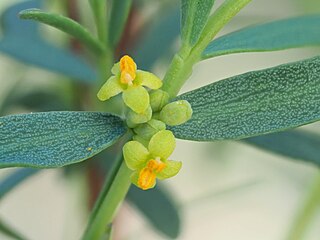
Pimelea pauciflora, commonly known as poison rice-flower, is a species of shrub in the family Thymelaeaceae. It has small yellow-lime flowers, green, smooth fleshy leaves and is endemic to Eastern Australia.

Petrophile anceps is a species of flowering plant in the family Proteaceae and is endemic to a restricted part of southwestern Western Australia. It is a shrub with sharply-pointed, linear leaves and oval heads of hairy yellow flowers.
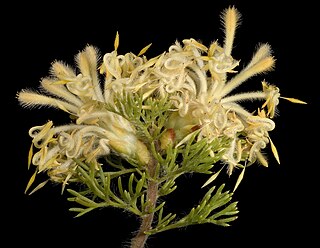
Petrophile serruriae is a species of flowering plant in the family Proteaceae and is endemic to southwestern Western Australia. It is a shrub with crowded, pinnate, needle-shaped, sharply-pointed leaves, and oval heads of silky-hairy yellow, greyish mauve to pink flowers.

Goodenia coerulea is a species of flowering plant in the family Goodeniaceae and is endemic to the south-west of Western Australia. It is an erect, perennial shrub or biennial herb shrub with linear leaves at the base of the plant, sometimes with a few teeth on the edges, racemes of blue flowers and oval fruit.

Goodenia decurrens is a species of flowering plant in the family Goodeniaceae and is endemic to New South Wales. It is an erect, glabrous undershrub with lance-shaped to elliptic, toothed leaves, yellow flowers arranged in racemes or thyrses, and oval fruit.
Goodenia filiformis, commonly known as thread-leaved goodenia, is a species of flowering plant in the family Goodeniaceae and is endemic to near-coastal areas of south-western Western Australia. It is an erect to ascending herb with cylindrical to narrow linear leaves at the base of the plant and racemes of yellow flowers.
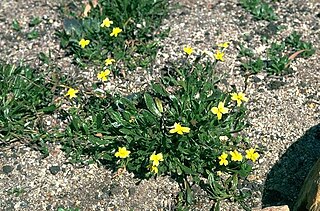
Goodenia geniculata, commonly known as bent goodenia or native primrose, is a species of flowering plant in the family Goodeniaceae and is endemic to south-eastern Australia. It is a low-lying to ascending herb with linear to lance-shaped, often toothed leaves at the base of the plant and racemes of yellow flowers with hairy backs.

Goodenia glabra, commonly known as shiny pansy or smooth goodenia, is a species of flowering plant in the family Goodeniaceae and is endemic to drier inland areas of Australia. It is a prostrate to low-lying herb with lobed, oblong to egg-shaped leaves, and racemes of yellow flowers with purplish markings.
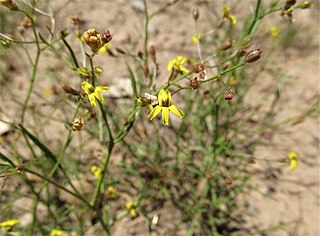
Goodenia gracilis, commonly known as slender goodenia, is a species of flowering plant in the family Goodeniaceae and is endemic to Australia. It is a annual or perennial herb with linear to lance-shaped leaves and racemes of yellow flowers.
Goodenia hispida is a species of flowering plant in the family Goodeniaceae and is endemic to the Northern Territory. It is a herb with egg-shaped to lance-shaped stem leaves and racemes of yellow flowers.

Goodenia humilis, commonly known as swamp goodenia, is a species of flowering plant in the family Goodeniaceae and is endemic to south-eastern Australia. It is a weak, perennial herb with linear to lance-shaped leaves mostly at the base of the plant, and racemes or thyrses of yellow or yellowish-brown flowers.
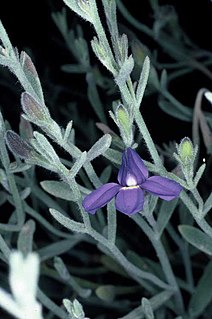
Goodenia incana is a species of flowering plant in the family Goodeniaceae and is endemic to the south-west of Western Australia. It is an ascending herb covered with silvery-white hairs, with linear to lance-shaped leaves mostly at the base of the plant, and racemes of blue flowers.
Goodenia odonnellii is a species of flowering plant in the family Goodeniaceae and is endemic to northern Australia. It is an erect to low-lying herb with oblong to egg-shaped leaves with toothed or lyrate edges, and racemes of yellow flowers.















